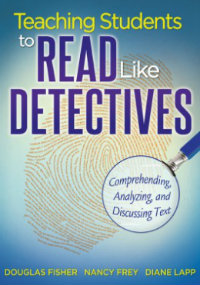Turn Students into Sleuths
Teaching Students to Read Like Detectives: Comprehending, Analyzing, and Discussing Text
By Douglas Fisher, Nancy Frey and Diane Lapp
(Solution Tree Press, 2012 – Learn more)
TEACHER: Let’s talk about this book we’ve read. What do you notice about the main character?
STUDENT #1: She’s nice.
STUDENT #2: Yeah, she’s a good person.
TEACHER: What are the clues in the book that make you think she’s “nice” and “good’?
STUDENT #3: She does good stuff just like my big sister.
STUDENT #1: Right, just like my cousin when she watches me after school.
STUDENT #4: Or like my brother when he helps me with my homework.
TEACHER: What does the character do in the story that reminds you of your sister, or cousin, or brother?
STUDENT #2: She is nice to people.
TEACHER: Can you show me where in the story you see the character being nice to people?
STUDENT #3: It’s everywhere in the whole story!
How often have you experienced a scenario like this in your classroom?
Many times students are able to make connections between what they read and their own lives, but cannot pinpoint specific textual evidence to support those connections. In addition, the Common Core State Standards for English Language Arts require that students engage in text-supported thinking, discussion, and writing.
If, like me, you sometimes struggle in bringing students back to the text to support their answers, you will appreciate the variety of strategies, examples and resources that the authors include in Teaching Students to Read Like Detectives: Comprehending, Analyzing, and Discussing Text. Douglas Fisher, Nancy Frey, and Diane Lapp state that this book is about “teaching students to return to the text in their discussions.” Seems like a modest goal, right? But those of us who work with readers of varying abilities in our classrooms know what a challenge it can be!
Teachers of all grade levels and content areas can better meet this challenge by using this resource to follow Common Core project editor David Coleman’s suggestion that “students…read like detectives and write like reporters.”
The introduction provides an overview of changes in our perceptions of literacy, as well as a sampling of how the Common Core State Standards impact English Language Arts in K-12 education. The authors also treat us to a crash course in the history of literacy education theories in the United States, and then swiftly move on to a discussion of the basic principles of effective literacy instruction, including classroom culture and lesson structure, as well as the major comprehension strategies.
Teaching “text-supported thinking and collaboration”
With this background knowledge in place, the next three chapters – more than half of the book – become a handbook for teaching “text-supported thinking and collaboration.” Fisher, Frey and Lapp take us through the three CCSS text types (argumentation, narration, and exposition) with lively explanations punctuated by transcripts of student and teacher conversations that illustrate the various strategies and concepts central to each type.
These scenarios are drawn from various grade levels (elementary, middle, and high school) as well as content areas, and include examples from science, social studies and even a Family and Consumer Science class. Content-area teachers as well as English Language Arts teachers will find these chapters a great reference tool for planning meaningful classroom discussions.
Teacher-friendly features
Teachers familiar with Harvey and Goudvis’s Comprehension Toolkit, or with the work of Lucy Calkins’ Teachers College Reading and Writing Project, will recognize similar language and approaches to instruction such as accountable talk and the gradual release of responsibility model of instruction, but you need not be “in the know” to understand and apply the myriad suggestions made throughout.
The authors have thoughtfully included a slew of diagrams, tables, photographs, rubrics, illustrations, and other resources that make their work teacher-friendly. For example, in the chapter on expository texts, there is a table that lists the various types of text structures that may be encountered, along with signal words that can help readers identify the type of text they are reading. Also included are 13 pages of references and resources that run the gamut from Click, clack, moo: Cows that Type to Ameliorating children’s reading-comprehension difficulties: A randomized controlled trial.
Three-dimensional reading, digitally speaking
You may be asking, “What about digital texts?” Don’t worry; they are covered, too. In fact, the relatively slim 15-page Chapter Five “Analyzing and Discussing New-Media Texts” is my favorite part of the book.
The authors discuss how comprehension may be challenged and/or enhanced by the non-linear reading methods required by hypertext, identifying the process as three-dimensional reading. They also address the issue of reader engagement in new-media texts. The chapter concludes with an extended classroom example that shows how a middle-grades teacher uses the gradual release of responsibility model while incorporating various types of media in a research project.
Wherever you are on your journey with your students to improve text-based critical thinking and discussion, you will find a wealth of ideas and resources here to speed you on your way.
Joan Cansdale is a middle grades educator and English Language Arts supervisor. She enjoys networking with other educators on Twitter @joancansdale. Joan also recently embarked on a mission to read all of Walter Dean Myers’ 105 published titles. She blogs about her progress at http://wdmandme.wordpress.com




































Awesome review! I am looking forward to reading this book and using the strategies. It’s always useful to find something that will help support the demands of the common core. Your insights have inspired me to seek out this resource!
Thank you for your comment. I think teachers will find this book to be a resource they will turn to many times. English teachers should share it with their content-area colleagues, too!
Nice work, Joan! I’ve heard good things about this book and I’ve use Middle web before. I’ll look for the book and revisit the site soon. I’ll link from my own site (in development), as well.
Thanks,
-Myke
Thank you! Your review helped our staff come to a decision on which book we wanted to read for our Casual Cafe Book Study! Looking forward to reading it! :)